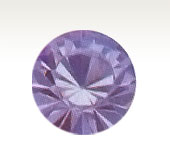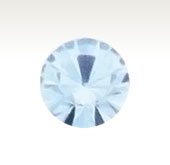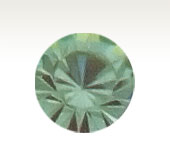|
|

Exotic Gemstones
Gemstones have distinct personalities and can be described by both their physical characteristics and their alluring historical, social and cultural significance. Exotic gemstones are ideal for jewelry lovers who stray from the mainstream and enjoy being different. That means choosing gemstones that change color, are very exclusive, or are just lesser-known or under-appreciated. If you want to possess a gemstone few people own (or even know about) shop exotic gemstones like tanzanite, alexandrite and aquamarine.

Tanzanite
|
Tanzanite Characteristics
- Tanzanite is more than 500 million years old and 1,000 times rarer than diamonds.
- The gemstone is bluish-violet, but also come in rarer greenish and greenish-blue hues. Blue tanzanite is a little pricier than gemstones with a purplish-blue color.
- Tanzanite is highly pleochoric, which means the color of the gemstone changes at different angles. This optical illusion is caused by light double refracting, making the front and top of the gemstone appear blue and the back more of a purple color.
- Trace amounts of vanadium give tanzanite its blue-purplish color.
- Large gemstones are uncommon, but large tanzanite gemstones have been found. The largest crystal was discovered in 2005 and weighed 16,839 carats!
- Tanzanite is a softer gemstone and should be carefully cared for and cleaned without using a sonic jewelry cleaner.
Tanzanite Origin
- The gemstone's scientific name is blue zoisite. It was renamed "tanzanite" by Tiffany & Co. in 1968 and honors its Tanzania origin, the only known source of tanzanite in the world. The gemstone was renamed because the jeweler thought the English pronunciation of zoisite sounded too much like the word "suicide."
- The gemstone is exclusively found in Africa's Tanzania. The gemstone has only been found in a several square mile segment of the Merelani Hills at the base of Mount Kilimanjaro.
- The government took control of the tanzanite mines in 1971 and turned them over to the State Mining Company in 1976 to be regulated and controlled.
- Small-scale mining companies hire and license locals who hand-excavate the mining shaft and trade in Merelani.
Tanzanite Folklore
- Legend has it, Masai cattle herders found tanzanite 30 years prior to mining. Lightning caused a brush fire and the herders noticed the brown crystals on the ground were replaced with purple-blue gemstones. Heating (called burning) is customary practice with this gemstone.
- The mine is expected to be depleted of tanzanite in a decade, causing this extraordinarily rare gemstone to become even more valuable.
|
Aquamarine
|
Aquamarine Characteristics
- Aquamarine is Latin for "seawater." Ancient texts call it "sea-green beryl."
- Dark blue aquamarine is the most precious color of aquamarine today. In the 19th century, sea green varieties were more valuable.
- Aquamarine has almost no inclusions, making it less susceptible to nicks and cracks. This durability allows jewelry settings to safely display more of the gemstone than its cousin, the emerald.
- An emerald-cut is a popular choice for aquamarine, to bring attention to the gemstone's frequently flawless surface.
- Iron gives aquamarine its vibrant blue color. Its incredible transparency makes small gemstones with deep color extremely rare.
Aquamarine Origin
- Surprisingly, aquamarine can be found in large pieces. While it's strange to find precious gemstones weighing several carats, it's not unusual to find aquamarine crystals stretching up to three feet.
- The largest aquamarine gemstone was found in Brazil and weighed 243 pounds! After its discovery in 1910, it was cut into smaller stones equaling more than 200,000 carats.
- Historically, Madagascar was the most important source of aquamarine, producing medium sized, dark blue stones. Most of the raw crystals today come from Brazil and are mostly bluish-green gemstones.
- Aquamarine is also found in central Colorado and became the state's official gemstone on April 30, 1971.
- Aquamarine has been found in tombs of ancient Egyptian mummies, left as a tribute to the gods ensuring a safe passing to the next world.
Aquamarine Folklore
- Egyptians, Sumerians and Hebrews used aquamarine to symbolize happiness and everlasting youth.
- Its first documented use was between 480 and 300 B.C. when Greeks wore aquamarine amulets engraved with Poseidon sitting on a chariot. The myth follows that the God of the Sea treasured the gemstone and gave it to the mermaids, whose scaly tails were also made of aquamarine.
- Aquamarine is called the sailors' lucky stone. Ancient Greek and Roman sailors would travel with the gemstone, believing it will ensure a safe trip, prevent seasickness and provide sound sleep when placed under pillows.
- Royalty and other wealthy Europeans would wear aquamarine jewelry to prevent fatal poisoning by envious enemies.
- Ancient literature describes aquamarine as a tool to find lost or hidden things. People would dangle the gemstone from a string over a bowl of water and the alphabet and use it much like an Ouija board to answer questions.
- Medieval tradition says that wearing aquamarine will bring a happy marriage by helping couples smooth out problems and reawaken their love for one another.
- The Romans believed carving a frog onto aquamarine turned enemies into friends.
- Aquamarine has been said to cure headaches, mouth and digestive ailments, insomnia, eye problems and laziness. It was believed to increase brainpower, courage and youthfulness.
|
Alexandrite
|
Alexandrite Characteristics
- Known as an "emerald by day, ruby by night," this extremely rare, highly coveted and very costly gemstone changes color depending on the type of light surrounding it.
- The most valuable alexandrite is grass-green and drastically turns raspberry-red in artificial light.
- The vast majority of alexandrite changes color slowly, unevenly, or has too much chrome for a significant color change.
- Alexandrite can be blue, blue-green or yellowish-green in daylight or fluorescent light. The gemstone can turn violet, red-violet or blue-red in incandescent light.
- A gemstone is only labeled natural alexandrite if it is a chrysoberyl with a notable color-changing quality. Natural alexandrite often has a yellow or brownish hue.
- The color-changing phenomenon alexandrite displays is called pleochroism. The chemical composition of alexandrite makes the gemstone appear a different color when saturated with red light waves.
- Alexandrite is extremely rare because it needs the combination of three elements that are almost never found together, especially in large quantities: beryllium and chromium supply the infamous color-changing ability and silica prevents the alexandrite from turning into an emerald.
- Multi-faceted alexandrite weighing more than one carat is among the most expensive gemstones in the world. Although it's unusual to find alexandrite weighing over five carats, miners have found gemstones as large as 65 carats in Sri Lanka.
Alexandrite Origin
- Alexandrite was discovered in the 1800s near the Tokovaya River in Russia's Ural Mountains. There are multiple tales about how the gemstone was named and found, but they all involve the Royal Russian Family.
- The most popular legend is that Finnish mineralogist Nils Gustaf Nordenskiöld discovered the stone on April 17, 1834 and named it after Czar Alexander II in honor of the Prince's 16th birthday.
- At the time of discovery, green and red were the colors for Russia's military. Hence, Alexandrite became Russia's national stone and a favorite among its aristocrats.
- Tiffany's master gemologist, George Kunz, adored the gemstone and bought large Russian reserves that cornered the market for decades.
- When a Brazil alexandrite source was discovered in 1987, it revived the gemstone's demand. Brazilian alexandrite has the most drastic and noticeable color changes. However, Russian alexandrite is known for the richest color and is the rarest in the world. Gemstones from both countries are extremely costly.
Alexandrite Folklore
- For a relatively modern gemstone, alexandrite has a rich history attributed to only positive qualities and good luck.
- In Russia, the gemstone is said to bring good omens.
- Legend has it that an extremely self-disciplined person will find joy and romance with alexandrite.
- The chameleon-like gemstone is said to balance the physical world with the spiritual world.
- It is also believed that Alexandrite promotes self-esteem, help wearers center themselves and heightens creativity, intuition and imagination.
|
 |






